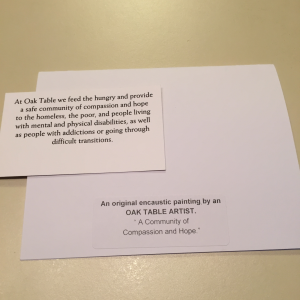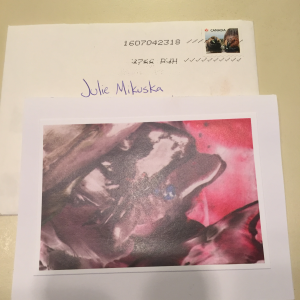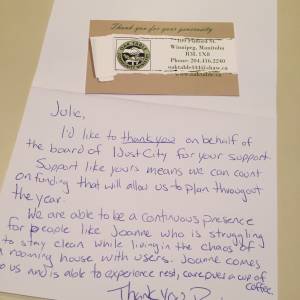Practice donor love principlesI had the privilege of speaking about the seven Donor Love principles at three workshops earlier this year. These principles were coined by John Lepp and Jen Love, who run an agency in Toronto called Agents of Good. Since they first appeared, the donor love principles (and principals) have been presenting at conferences and in blog posts by John and Jen and others. So how do you practice #donorlove? Principle 1: You make your donor the hero. You tell them in every email, direct mail piece, every newsletter. Give them an opportunity to fix the world. They want to help. They want to fix something. They want to make a difference. (And remember, they don’t give because you’re great. They give because they’re great.) Principle 2: Share amazing and inspiring stories. Stories are how you connect to your donors’ emotions. They must be able to feel and see who they’re helping. And if the problem is too big, they’ll ignore it. Remember the single story and image of Alan Kurdi, the Syrian boy who was found washed up on the beach in Greece. That was the story that finally put a heartbreaking face on the refugee crisis. Principle 3: Connect to your donors’ values and emotions. People give when they’re mad, sad, hopeful, conflicted, angry, frustrated – you name it. They’re moved to act when the feel something and feel they can make a difference. Principle 4: Falling and staying in love. You’re building a relationship with a donor. What can make them feel good about their decision to give? Think about donor love from their perspective – what moves them? Principle 5: Ask for one thing. Donors want to help fix something and feel really good about it. So tell them what the problem is and how they, the donor, can be the solution. You need to make it easy with a clear call to action. Don’t give them a dozen choices or ask them to renew their membership at the same time. Principle 6: Who or what is the right voice for your story? What are you asking and who is the right voice for the question? It’s not always the executive director, development director or board chair. Sometimes it’s a grateful recipient of service. Sometimes a program staff or volunteer. And sometimes it’s a bird, a food truck or dining room table (at a women’s shelter). Use your imagination. Principle 7: Say thanks with passion. Don’t back into a thank you – just come out and say it! Don’t say “On behalf of the Board of Directors…” Say “Thank you so much for giving this person back their life” or “Because of you, this happened to change someone’s life. Thank you.” Tell them about the impact of their gifts. Use emotion and creativity and above all, be sincere. The 7 principles work. You need to be consistent in applying them and not give in to trying to educate donors. You must tell donors they are making a difference in the world. And thanks so much to the Agents of Good for defining the #donorlove principles! Julie Mikuska. · What’s the cost of a lost opportunity?We often hear people talk about the return on investment related to particular fundraising activities. (We often hear people never talking about ROI, but that’s for a different post!). But how many consider the opportunity costs of their decisions? In other words, what are you not able to do if you do something else? Consider:
Maximize your time and opportunities to meet donors, thank donors and ask people for gifts. Measure your activities against opportunity costs. Always ask yourself: do you need to do something or is it time to move on to a different activity with higher potential? Julie Mikuska. · Silos hold grain, not donorsHave you encountered these scenarios?
In all of these cases, staff are working in silos. They are protecting their turf because they don’t see how it’s in their interest to open their processes and departments to be donor-focused. What can you do to knock down the silo walls?
And don’t keep your donors in your own silo. Share stories of joyful giving with others to show them that donors care. Julie Mikuska. · Taking choice away from your donorsAre you taking choice away from your donors or potential donors by not asking them to give? Are you assuming they can’t or won’t give and so you don’t ask? We’ve heard it often. “Oh, we can’t ask that person. They have kids in university so they will have no money for us.” “Our patrons are low-income. They don’t have any money to donate.” “We can’t ask her! She just gave us a big gift.” All of these excuses are based on what you assume about people. By not asking, you are taking away their opportunity to make a difference in the world through your organization. Remember – it’s not about the money. It’s about the donor feeling good about the effect she can have on people who need her help. Think about it:
Ask yourself why you’re not asking. Julie Mikuska.
· A true giftI received a lovely gift in the mail today – a handwritten thank you on a card featuring the artwork of a client, hand-addressed with a real stamp on the envelope. A real stand-out in my mailbox! The card was from 1JustCity, an umbrella organization in Winnipeg bringing together four community ministries: Oak Table, North End Stella Community Ministry, West Broadway Community Services and St. Matthews Maryland Community Ministry. They do amazing work and, in their own words, they “love the under-loved.” And we get to work with them as clients. And in one short card, they told me what a difference I’m making in the life of one person. And because I’m a monthly donor, I’ll think of Joanne and others like her every month as I’m notified of my donation through CanadaHelps. How are you thanking your donors? Julie Mikuska
· Donors are not widgetsDonors are not widgets. They are not interchangeable. You can’t pick up a new lot at the hardware store. And they need maintenance. Now, I’m sure most people in social impact organizations recognize that donors aren’t widgets, but why then is there a tendency to concentrate on getting new donors and not on keeping the ones you have? The longer donors stay with you, the longer they stay with you. And that means you don’t have to go out looking for so many new donors, many of whom won’t stay with you. Your loyal donors are the ones who get how important monthly giving is. And they may increase their annual gifts over time. Plus they are great candidates to approach about putting you in their wills. So concentrate on loving the people who already love you – the donors! Make strategies to get to know them and to let them know how important they are to you. Remember: they’re people, not widgets. Julie Mikuska · Invest in your peopleHands up all you fundraisers that rarely, if ever, get to attend a professional development session on fundraising. In this virtual room, my guess is that a lot of you metaphorically raised your hand. What other sector would place so little emphasis on professional development and continuous learning? A lot of social impact organizations see PD as an expense, and it’s usually the first thing to be chopped in the annual budget cutting exercise. That’s a short-sighted move that is detrimental to the entire organization. Investing in staff’s professional development is an investment in the organization. Learning new and innovative techniques, hearing about ideas that have worked in other organizations, and networking with other fundraisers can be a huge motivator. And chances are greater that you’ll remain in your position far longer if you aren’t looking around for an organization that’s willing to invest in you. A recently-released study, Major Gift Fundraising: Unlocking the Potential for Your Nonprofit, also revealed that for every PD opportunity that a fundraising staff attended, there was a strong correlation to fundraising performance. “Each additional form of training/education is associated with an increase of $37,000 (USD) in income.” That’s astonishing! Now point that out to your ED/CEO and get your training back in the budget. Laura Mikuska · Are your appeals appealing?Another year end come and gone, and with it some hits and misses in appeals and thank yous… First, the face palms: 1. A weak call to action.
These were taken from the first three randomly chosen letters in the pile of appeals! (And yes, one letter contributed two of these…) 2. Not paying attention to good customer service or donor preferences.
3. Not talking about real impact.
And now the high fives: 1. Making the donor the hero.
2. Using stories to show impact.
3. Sincere thank yous
4. Clear calls to action.
Communication really matters, whether it’s good or bad. And with the Fundraising Effectiveness Report telling us that for every 100 donors gained in 2014, 103 were lost through attrition, good communication is key. Are you communicating in a way that donors say yes? Julie Mikuska. P.S. For opinions from a donor on her experience donating to various charities, follow The Whiny Donor on Twitter @thewhinydonor. (This article originally appeared in our January 2016 e-newletter. Subscribe here.) · How and when to thank donorsThe time to thank a donor is when you get a gift. That’s all. No mysterious formula. It’s not when you get enough gifts in to batch receipts. It’s not really about the receipt, although most people would like one eventually. If the process for creating receipts in your organization are making you wait to thank donors, then get the thank you letter out first and send the receipt later – then work on getting the receipt process changed! How to thank donors is also quite simple.
Donors are much more likely to give again if they are promptly and properly thanked. So make time to do just that. Julie Mikuska. · Create your communityCreate your community, and invite your donors to be a part of it. That sounds better than asking for money, doesn’t it? This message came through loud and clear at a recent panel discussion held by the AFP Manitoba Chapter. Panellists Beth Proven, CFRE (Children’s Hospital Foundation of Manitoba), Christina Barwinsky, CFRE (St. John’s Ravenscourt School) and Leslie Weir, MA, CFRE, ACFRE (The Winnipeg Foundation) told stories about how donors respond to a community where they can feel a sense of purpose and belonging. Appeal to their desire for connection, their innate curiosity and willingness to engage, and you’re on your way to creating a community. Beth cited the Isbister Society at the University of Manitoba as a successful community of donors who had left a gift to the U of M in their will. It has grown substantially since its inception, due to the outings it offers to its members. Many are older donors who still connect with their former classmates, and many found their spouses on campus as well. Christina urged us to show our donors our love for what we do, and our organizations – first impressions count! She cited her love for SJR – as a graduate, she already has a sense of belonging to the community, and works hard to make sure she brings new parents and students into the fold, and graduates maintain their connection to the community. Leslie reminded us that what worked in one organization may not work in your current one. She advised us to provide an open, welcoming community and to be natural and genuine in your relationships with donors. Be nice to people! Welcome people into your community – they’ll be more likely to invest in it. Can you see yourself doing this? Laura Mikuska · |
Blog Archives
Articles By Category
|










